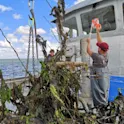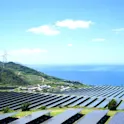Environment
12 Mar 2024
Beer byproduct behind Marmite could help us recycle metal waste
Scientists use spent brewer’s yeast, left over from manufacturing beer, to filter out metal from waste streams.
Environment
12 Mar 2024
Scientists use spent brewer’s yeast, left over from manufacturing beer, to filter out metal from waste streams.

Environment
13 Dec 2023
Scientists say vast quantities of methane may be trapped beneath the permafrost, and it could escape if it thaws

Environment
04 Dec 2023
Scientists have found a way of capturing DNA from snow tracks — a promising non-invasive method of monitoring elusive animals like polar bears.

Environment
14 Nov 2023
by Liad Hollender, Frontiers science writer Image: Shutterstock.com The UN Climate Panel’s latest best estimate is that global warming will end once we reach net zero CO2 emissions – but a study in Frontiers in Science warns significant warming could still occur. Researchers including those from Imperial College London and University of Exeter assess factors controlling global temperatures post ‘net zero’ and offer a pioneering framework for better estimating climate change risks. These risks must inform climate mitigation and adaptation policies to protect future generations. From scorching heatwaves to torrential downpours and devastating storms, the disastrous effects of global warming are sweeping across the world. Being the predicted outcome of burning fossil fuels, our best and only plan to limit warming is to reduce CO2 emissions from human activities to ‘net zero’ – where the amount of CO2 we emit into the atmosphere is equal to the amount we remove from it. To keep within the 1.5°C limit of the 2015 Paris Agreement, this needs to happen as soon as possible. Though the scientific community’s current best estimate from models is that global warming will stop at net zero, an article published in Frontiers in Science raises a red flag. […]

Environment
09 Nov 2023
by Deborah Pirchner, Frontiers science writer Image: Shutterstock.com Forests are excellent at absorbing and storing carbon and can play a role in meeting global net zero targets. As more countries commit to forest creation, but mainly plant single species forests, an international team of researchers has examined how carbon stocks in mixed forests and monocultures compare. They found that mixed forests store more carbon, and that out of the forests assessed those with four species had the highest carbon stocks relative to monocultures. To slow the effects of climate change, conserve biodiversity, and meet the sustainable development goals, replanting trees is vital. Restored forests store carbon within the forest’s soil, shrubs, and trees. Mixed forests are especially effective at carbon storage, as different species with complementary traits can increase overall carbon storage. Compared to single-species forests, mixed forests are also more resilient to pests, diseases, and climatic disturbances, which increases their long-term carbon storage potential. The delivery of other ecosystem services is also greater in mixed species forests, and they support higher levels of biodiversity. Although the benefits of diverse forest systems are well known, many countries’ restoration commitments are focused on establishing monoculture plantations. Given this practice, an international […]

Environment
06 Nov 2023
by Deborah Pirchner, Frontiers science writer Image: Shutterstock.com At Frontiers, we bring some of the world’s best research to a global audience. But with tens of thousands of articles published each year, it’s impossible to cover all of them. Here are just five amazing papers you may have missed. Carnivore territories might soon overlap – and some species profit more than others Some of Europe’s large carnivore populations, including jackals and lynxes, are growing and expanding their territories. The golden jackal, a wolf-like generalist that once occupied only the Balkan area, is currently expanding its territory. At the same time, the Eurasian lynx, a specialized predator previously hunted close to extinction, is slowly recovering. Writing in Frontiers in Ecology and Evolution, researchers have now modeled jackal and lynx distribution in Europe for current and future scenarios. Currently, it is estimated that the overlap of jackal and lynx territories is 13%. This overlap is likely to increase, given both species’ expansion. The researchers’ findings showed that both predators expanding their territories, leading to a dynamic where they coexist for the first time, may favor one species and threaten the other: Their predictions show an increase in habitat suitability for the golden […]

Environment
13 Oct 2023
By Mischa Dijkstra, Frontiers science writer Texas ocelot, Leopardus pardalis albescens. Image credit: Kline Lab, University of Texas Rio Grande Valley Traffic collisions are a major cause of death of endangered Texas ocelots. Researchers have now shown that recently designed wildlife exits, meant to allow ocelots to leave highways surrounded by fences, function as they are designed to do. 10 mammal species apart from ocelots learned to use them correctly. The authors concluded that these exits are a useful conservation measure in Texas, not only for ocelots. The Texas ocelot (Leopardus pardalis albescens) is endangered due to historic hunting, habitat loss, inbreeding, and traffic collisions. Today, only between 50 and 80 ocelots remain in the US, exclusively in Willacy and Cameron counties in southern Texas. These two populations are isolated from the larger one in northwestern Mexico by highways and urban development. “Here we show that a range of species, including middle-sized carnivores such as bobcats and coyotes, successfully use wildlife exits, a new type of mitigation structure specifically designed for the US endangered ocelot,” said first author Zarina Sheikh, a former graduate student at the University of Texas Rio Grande Valley, about their new study in Frontiers in Ecology […]

Environment
05 Oct 2023
by Angharad Brewer Gillham, Frontiers science writer Image/Shutterstock.com Eating more plant-based dishes is good for your health and good for the planet – but the perception that these dishes are for women and not for men may be stopping some men from choosing plant-based meals. Scientists found that you can present vegan dishes with a masculine framing, altering the perception that these dishes are for women, but changing the perception doesn’t change people’s preferences. Eating more plant-based meals is better for our health and better for the planet. But cultural preferences are significant barriers to reducing meat consumption – especially for men, who are underrepresented among vegans and vegetarians. Studies have found that eating meat is associated with masculinity, and that gender stereotypes label plant-based diets as suitable for women but not men. So is it possible to change the perception of plant-based food with marketing, and convince men to eat more of it? “Men might be less inclined to consume vegan food due to the need to perform gender,” said Alma Scholz, lead author of a new study published in Frontiers in Communication. “However, with vegan food being framed in a masculine way, men might feel less resistance and […]

Environment
26 Sep 2023
by Dr Jennifer Grenz, University of British Columbia Dr Jennifer Grenz. Image: UBC Dr Jennifer Grenz is the principal investigator at The Indigenous Ecology Lab at the University of British Columbia. There, researchers apply an Indigenous, relational worldview to ecological restoration. Grenz has nearly two decades of experience providing consulting services and on-the-ground management of invasive species for all levels of government as well as working with Indigenous communities on creating food security plans and land healing initiatives consistent with community values and needs. Her current research focuses on applying an Indigenous worldview to invasive plant species on landscapes in British Columbia, challenging us to think differently about our role in ecosystems management as we face a rapidly changing climate. Together with Dr Chelsey Armstrong of the Historical Ecological Research Lab at Simon Fraser University, Grenz is co-author of a recently published Frontiers in Sustainable Food Systems article. In it, they introduce the concept of ‘pop-up restoration’, meaning fragmented, disconnected, privileged restoration that perpetuates colonial notions of naturalness. In this latest Frontiers guest editorial, she wrote about their latest work. Imagine you’re sitting in your living room on a quiet evening with your family reading a book, when suddenly, complete […]

Environment
18 Sep 2023
by Angharad Brewer Gillham, Frontiers science writer Image/Shutterstock Animals’ circadian clocks normally get cues from their environments: light cycles, seasonal food availability, and temperature. If these cues are very different to the ones from the latitudes which they have adapted to, it could disrupt their bodies and behavior, like jet lag in humans. Scientists studying the effect of this possible ‘jet lag’ on giant pandas, which are a vulnerable species and live in zoos worldwide, have shown that pandas housed in different latitudes to their normal range in China are less active, with potentially negative consequences for their welfare. All animals have an internal clock called a circadian clock, which is regulated by cues from their environment — but animals in zoos can be exposed to very different cues from animals in the wild. Since all animals’ circadian clocks are linked to their behavior and physiology, this could be significant to their welfare, which is crucial to maintaining captive populations of animals at high risk of extinction in the wild, like giant pandas. Scientists set out to understand how the ‘jet lag’ of living in latitudes they did not evolve in, and therefore getting cues for their circadian clocks which […]

Environment
14 Sep 2023
By Deborah Pirchner, Frontiers science writer Image: Shutterstock.com At Frontiers, we bring some of the world’s best research to a global audience. But with tens of thousands of articles published each year, it’s impossible to cover all of them. Here are just five amazing papers you may have missed. Polar bear identity and sex can be established from paw prints The recent loss of sea ice is forcing polar bears – one of the Arctic’s biggest predators – to spend more time on land closer to human settlements. To prevent potential human-animal conflicts and to protect the species, polar bear populations must be monitored and managed. More often than not, this is a costly and difficult endeavor, in part because of the remote regions the bears inhabit. Now, a team of researchers in the US has developed a method to keep track of polar bears that might make scientist less reliant on having to capture the bears to get data. Writing in Frontiers in Conservation Science, they investigated the use of environmental DNA – cells which the animals shed when walking – collected from paw-prints in the snow to identify individual polar bears and their sex. They sampled 13 polar […]

Environment
08 Sep 2023
by Angharad Brewer Gillham, Frontiers science writer Image/Shutterstock. With the changes in conditions caused by the climate crisis, the forests of the Italian Alps and Apennines are set to alter. Many species, including keystone species, will have smaller ranges to grow in. Some others may expand their ranges, possibly helping to maintain forests in the years to come. Scientists now warn that conserving our forests depends on detailed biodiversity modelling. As a result of the climate crisis, future forests may become unrecognizable. Trees that currently make up European woods may no longer be seen — or they may have moved several hundred meters uphill. Scientists writing in Frontiers in Forests and Global Change have mapped the forests of five vulnerable mountain areas in Italy and modelled the future of these fragile ecosystems. “If I imagine my daughter walking with me as an old man, in our mountain forests, I can imagine that we can see the initial stage of a profound change of species,” said Dr Sergio Noce of the Euro-Mediterranean Center on Climate Change Foundation (CMCC). “Like any natural process, time is needed, and forests have times that are totally different from us.” Seeing the wood for the trees […]

Environment
25 Aug 2023
By Mischa Dijkstra, Frontiers science writer One of the ‘tree-reefs’ being examined after five months in the Wadden Sea. Image credit: Jon Dickson Researchers have shown that structures made from culled pear trees sunk into soft-bottomed seas like the Dutch Wadden Sea provide excellent replacements for naturally occurring hard substrates, of which many have been lost due to human activities. These ‘tree-reefs’ were rapidly colonized and became hotspots for fish, crustaceans, polyps, and shellfish. Reefs, whether natural or man-made, are hotspots of marine biodiversity. But especially in soft-bottomed seas, reefs have now become scarce because many hard substrates have been removed due to overfishing of shellfish, dredging, trawling, and deep-sea mining. How can we restore this lost biodiversity, as encouraged by the UN Decade on Ecosystem Restoration (2021-2030) and the EU Biodiversity Strategy? Now, researchers have shown that culled fruit trees sunk into the sea are a cheap and effective way to recreate reefs and boost the local diversity and abundance of marine life. The study, published in Frontiers in Marine Science, was done in the Wadden Sea, a UNESCO World Heritage Site and the largest tidal flats system in the world. “Here we show that native marine […]

Environment
21 Jul 2023
by Angharad Brewer Gillham, Frontiers science writer Image/Shutterstock.com We know that microplastic contamination has reached the Arctic, but quantifying the amount that appears on beaches and understanding where it came from is difficult. Scientists asked tourists on Arctic cruises to take part in a program of sample collection while visiting Svalbard and used these samples to identify microplastics that probably originated from ships and fishing net. Tourists acting as citizen scientists have helped a research team detect microplastics on remote Arctic beaches. The global scale of plastic production means that these tiny fragments of plastic are now ubiquitous, and scientists fear that ocean currents will cause plastic to accumulate in the Arctic, damaging ecosystems. But our knowledge of the scale and type of plastic pollution in the Arctic is incomplete. Researchers recruited holidaymakers to carry out sample collection during cruises, hoping to fill in some of the gaps in their knowledge. “Plastic pollution is now ubiquitous. It is found on land and in soil and most rivers of the world,” said Dr Bruno Walther of the Alfred Wegener Institute, Helmholtz Centre for Polar and Marine Research, author of the study in Frontiers in Environmental Science. “It is even found in […]

Environment
17 Jul 2023
By Deborah Pirchner, Frontiers science writer Image: Shutterstock.com At Frontiers, we bring some of the world’s best research to a global audience. But with tens of thousands of articles published each year, it’s impossible to cover all of them. Here are just five amazing papers you may have missed. Solar parks can house semi-natural grassland communities Solar parks are sustainable ways to ensure clean energy. The ecosystems in which they are built are often sites that are excessively managed and affected by habitat destruction. This land management, however, also offers opportunity to restore or even create semi-natural grasslands. Researchers in France have studied 10 solar parks in the south of the country to examine plant community composition, soil biodiversity, and soil functioning under and outside of solar panels to test whether they hamper soil health. They have now published their results in Frontiers in Environmental Science. Their results indicate that the microclimate under panels influenced the abundance of soil megafauna, fungi biomass, and bacteria. Plant communities under panels tended to be made up of more shade-tolerant species, which reduced plant diversity and vegetation cover. Between panels, however, the researchers found more trophic interactions than outside or under solar panels. This suggested […]
Get the latest research updates, subscribe to our newsletter